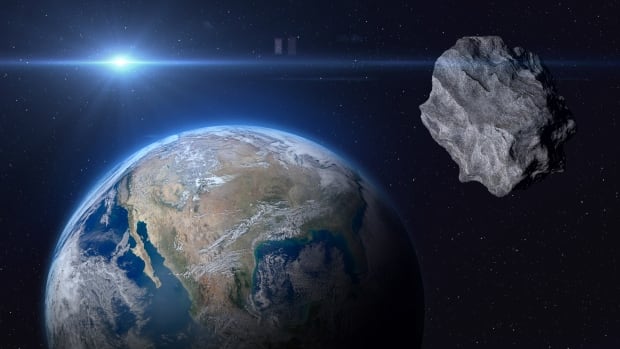Earth is surrounded by rocky bodies and bits of debris from when the solar system formed roughly 4.5 billion years ago. On Saturday, one of those leftover rocks will whiz past Earth.
The asteroid is called 2024 MK and, at its closest, it will pass roughly 290,000 km from Earth. While we have plenty of small asteroids that are scattered within Earth’s orbit, this one is sizeable, ranging anywhere from 120 metres to 260 metres in diameter.
But there’s another interesting — and somewhat disquieting — fact about this large asteroid.
“Maybe the big take-home point on this one is it’s a pretty big object and it was only found 10 or 12 days before closest approach,” said Peter Brown, Canada Research Chair in meteor astronomy and a professor at Western University in London, Ont. “The last time we had an object this big or bigger pass this close to Earth was … in 2001.”
“So unlike most asteroid stories, this actually is noteworthy in the sense of … this is pretty big, pretty close.”
According to Alan Fitzsimmons, a planetary scientist at Queen’s University Belfast in Northern Ireland, at its closest, 2024 MK will be visible from the southern hemisphere. The following night it will be in the constellation Scorpius, which is low in the south in Canada.
However, don’t expect to see it. It won’t be visible to the unaided eye, and, Fitzsimmons added to those who may have telescopes, “you’ve got to have to know exactly where to look. It’s motoring.”
Fortunately, it won’t impact Earth. But it would be a bad day if it did.
“This is a big object. An object of this size is going to have the equivalent impact energy in the hundreds of megaton approaching a gigaton,” Brown said. “That’d be a regional impact. It’s the sort of thing that if it hit the east coast of the U.S., you would have catastrophic effects over most of the eastern seaboard. But it’s not big enough to affect the whole world.”
Bigger, closer asteroids
The appearance of 2024 MK is timely. It’s passing by just nine days after NASA released a report on the results of an asteroid-threat simulation conducted in early April. And it’s making an appearance just one day ahead of Asteroid Day which is held annually on June 30.
Asteroid Day, sanctioned by the United Nations, was started in 2014 by astrophysicist and former Queen musician Brian May along with Apollo 9 astronaut Rusty Schweickart along with a few others. The goal is to inform the public about asteroids and their potential threats as well as calling on governments to work on asteroid detection programs.
The threat of asteroids or comets impacting Earth is a very real concern, though there are multiple sky surveys looking for potentially hazardous asteroids (PHA). In fact, one of them — the Asteroid Terrestrial-impact Last Alert System (ATLAS) — discovered 2024 MK last week.
Both Brown and Fitzsimmons say that at any one time there is a 10-metre asteroid somewhere between Earth and the moon. Essentially, Earth is plowing through debris all the time. Meteors burn up in our atmosphere all the time, it’s just that most of them are small and go unnoticed. Brown said that even bigger impacts may go unnoticed as they may impact over the ocean.
But in 1994, the astronomical world was shocked to see the effects of several pieces of a comet slamming into Jupiter, the largest planet in our solar system.

Then in 2013, the reminder that we’re in a cosmic shooting gallery hit home. On February 15, a 20-metre wide rock impacted over entered Earth’s atmosphere over Chelyabinsk, Russia, causing a massive air burst that blew out windows in the area, injuring roughly 1,000 people.
Fitzsimmons said that Asteroid Day is a reminder that we’re not just sitting ducks.
“It’s the only natural disaster that we can stop. You can’t stop a tsunami, you can’t stop an earthquake, you can’t stop a volcano,” he said. “You can actually stop or prevent an asteroid impact, in least in theory.”
And NASA put that to the test in 2021 with its Double Asteroid Redirection Test (DART) mission where it used a spacecraft to redirect an asteroid. It was hailed as a success, and a follow-up mission by the European Space Agency’s Hera mission to further quantify the results will launch in October.
NASA’s OSIRIS-REx mission, which visited the asteroid Bennu and returned a sample to Earth in 2023, has been given a new mission called OSIRIS-APEX. The spacecraft will visit the infamous asteroid Apophis.
At one point, it was believed the 320-metre-wide asteroid had a risk of impacting Earth in 2068, however, that has now been ruled out. But it will swing extremely close to Earth in 2029 — so close that it will be within the region of our geostationary satellites, at roughly 30,000 kilometres from Earth.
WATCH | Animation of Asteroid Apophis’ 2029 Close Approach with Earth and satellites:
“So [2024] MK is sort of the leader in the next four or five years to a couple of really big events,” Brown said. “Of course, the one everybody knows about is Apophis in April 2029. That’s a once-in-millennia event. Nothing in historic times has been that close, that big to us. But there’s also an asteroid called 2001 WN5, and it’s actually going to pass closer than 2024 MK. And it’s a monster. It’s a kilometre in size.”
Thankfully, NASA and other space agencies are working hard to find all the PHAs. To date it’s believed that most objects one kilometre and larger have been found.
As for 2024 MK, Fitzsimmons said that this is an opportunity for astronomers to study it, even if it is only a brief pass. A team at NASA’s Jet Propulsion Laboratory has plans to map it using Earth-based radar telescopes.







